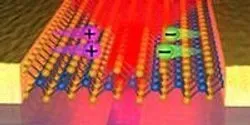electronics

Most modern electronics, from flat-screen TVs and smartphones to wearable technologies and computer monitors, use tiny light-emitting diodes, or LEDs. These LEDs are based off of semiconductors that emit light with the movement of electrons. As devices get smaller and faster, there is more demand for such semiconductors that are tinier, stronger and more energy efficient.

The Graphene Research Centre (GRC) at the National University of Singapore (NUS) Faculty of Science and the world’s leading chemical company BASF have partnered to develop the use of graphene in organic electronic devices, such as organic light emitting diodes (OLED). The goal of this collaboration is to interface graphene films with organic electronic materials for the creation of more efficient and more flexible lighting devices.

Researchers at the Department of Energy’s Oak Ridge National Laboratory and the University of Tennessee, Knoxville have pioneered a new technique for forming a two-dimensional, single-atom sheet of two different materials with a seamless boundary.
















